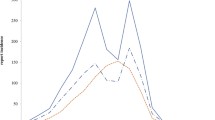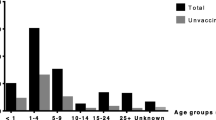Abstract
Before the measles–mumps–rubella (MMR) vaccination was widely offered, the epidemiologic data about mumps (morbidity, immunization level, vaccine coverage) were analyzed in Piedmont region (Italy). The disease had a 3- to 5-year epidemic recurrence with morbidity rate between 40 and 150/100,000; the surveillance conducted by ‘sentinel’ pediatricians showed that the notifications underestimated the real data by about 5- to 7-fold. The 12-year-old subjects showed an immunization level (reached by the disease or the vaccination) of about 50% and their parents tended to refuse the MMR vaccination. Only 54% of the 3- to 5-year-old children received the MMR vaccine in the second year of life and the frequency of the vaccination failure was about 10%. The strategy of vaccination should take into account this epidemiologic pattern, to program an offer adequate to reach mumps control/elimination; the strategy of our region should include the active offer in the second year of life to reach higher coverage, a second offer at 4–6 and/or 12 years of life, when other vaccinations are given and the choice of a highly efficacious vaccine. The improvement of the notification system could also allow a more sensitive surveillance of epidemiologic patterns.
Similar content being viewed by others
References
Advisory Committee Immunization Practices (ACIP). Mumps vaccine. MMWR 1977; 26: 393–394.
Advisory Committee Immunization Practices (ACIP). Mumps vaccine. MMWR 1980; 29: 87–88, 93–94.
Cochi SL, Preblud SR, Orenstein WA. Perspective on the relative resurgence of Mumps in the United States. Am J Dis Child 1988; 142: 499–507.
Wharton M, Cochi SL, Hutcheson RH, et al. A large outbreak of mumps in the postvaccine era. J Infect Dis 1988; 158: 1253–1260.
Sosin DM, Cochi SL, Gunn RA, et al. Changing epidemiology of mumps and its impact on University Campuses. Pediatrics 1989; 84: 779–784.
Hersh BS, Fine PEM, Kent WK, et al. Mumps outbreak in a highly vaccinated population J Pediatr 1991; 119: 187–193.
Peragallo MS. Le malattie esantematiche nelle Forze Armate: attualità e prospettive in tema di prevenzione. Professione, Sanità Pubblica e Medicina Pratica 1997; V(1): 8–15.
Peltola H, Heinonen O, Valle M, et al. The elimination of indigenous measles, mumps and rubella from Finland by a 12–years two dose vaccination program. New Engl J Med 1994; 331: 1397–1402.
Christensen B, Bottiger M. Changes of the immunological patterns against measles, mumps and rubella. A vaccination programme studied 3 to 7 years after the introduction of a two dose schedule. Vaccine 1991; 9: 326–329.
Broliden K, Abreu ER, Arneborn M, et al. Immunity to mumps before and after MMR vaccination at 12 years of age in the first generation offered the two-dose immunization programme. Vaccine 1998; 16: 323–327.
Gay N, Miller E, Hesketh L, et al. Mumps surveillance in England and Wales supports introduction of two dose vaccination schedule. Commun Dis Rep Rev 1997; 7: R21–R26.
Mitchell LA, Tingle AJ, Decarie D, et al. Serologic responses to measles, mumps and rubella (MMR) vaccine in healthy infants: Failure to respond to measles and mumps components may influence decisions on timing of the second dose of MMR. Can J Public Health 1998; 89: 325–£.
Bulletin Office fédéral de la santé publique. Cas d'oreillons chez des enfants vaccinés en Suisse. Information sur la situation au début 1993. 1996; 11: 183–188.
Dias JA, Cordero M, Afzal MA, et al. Mumps epidemic in Portugal despite high vaccine coverage — preliminary report. Eurosurveillance 1996; 1,4: 25–28.
Zotti C, Cortese MG, Fuoco F, et al. Vaccino trivalente anti morbillo-rosolia-parotite: immunogenicità a breve termine di differenti preparati commerciali. Abstract book C14; 36° Congresso Nazionale SItI. Sassari-Alghero 1994, p 25.
Germann D, Strohle A, Eggenberger K, et al. An outbreak of mumps in a population partially vaccinated with the Rubini strain. Sand I Infect Dis 1996; 28: 235–238.
Anonymous (The Benevento and Campobasso Pediatricians Network for the Control of Vaccine-Preventable Diseases). Field evaluation of the clinical effectiveness of vaccines against pertussis, measles, rubella and mumps. Vaccine 1998; 16: 818–822.
Author information
Authors and Affiliations
Additional information
Collaborating Group: A. Gallone (ASL 5); M. Fani' (ASL 6); F. Valtorta (ASL 7); M. De Simone (ASL 8); M.P. Alibrandi, G. Barone (ASL 9); B. Nucci, M. Farina (ASL 10); I. De Fabiani (ASL 11); G. Ara (ASL 12); M. Barengo (ASL 14); R. Sclavo (ASL 16); D. Montu' (ASL 17); D. Rivetti (ASL 18); E. Sperandio (ASL 20); L. Comeri (ASL 22)
Rights and permissions
About this article
Cite this article
Zotti, C., Ossola, O., Barberis, R. et al. Mumps: A current epidemiologic pattern as a necessary background for the choice of a vaccination strategy. Eur J Epidemiol 15, 659–663 (1999). https://doi.org/10.1023/A:1007691509030
Issue Date:
DOI: https://doi.org/10.1023/A:1007691509030




